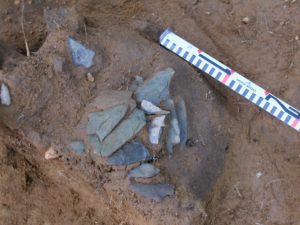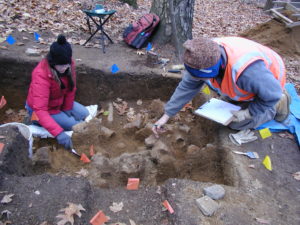Dibble Creek 1

Located on a terrace adjacent to Dibble Creek (a tributary of the Salmon River), the Dibble Creek I site was an upland base camp from the Late Archaic through the early Middle Woodland periods. This camp is associated with a community within the Narrow Point artifact tradition.
Food remains from Dibble Creek show that occupants exploited resources such as white-tailed deer, nuts, and acorns. Surprisingly, despite its proximity to Dibble Creek and the Salmon River, there was a complete lack of evidence indicating riverine oriented subsistence strategies such as fishing and river plant gathering. This may suggest that the site was occupied during the winter season when such activities were not viable. It could also be a result of preservation bias, as botanical remains tend to disintegrate relatively quickly. Most likely, however, the absence of riverine plant and fish remains indicates that this group subsisted largely on terrestrial resources.
The most compelling discovery at Dibble Creek was a cache of Broad Spear blades found in situ. It is likely that these blades were intentionally buried for storage underground within the living space of the camp. Excavators found a layer of fine sand placed between each later of blades which would have served as protection to keep them from being damaged or broken. The blades were made from no local materials such as chert, slate, and basalt. It is possible that these were trade materials from a contemporaneous Broad Spear community. Whoever stored these blades did so with utmost care, and likely with the intention of returning to Dibble Creek as part of their seasonal subsistence round. This was an easy way to keep the blades handy for when the site’s occupants returned instead of carrying them all year from place to place.
Typically, when people think of Native American stone tools, they picture “arrowheads” or “spears” that were used for hunting. While this was sometimes the case, prehistoric people developed extensive lithic toolkits with many specialized tools that were used for a variety of purposes. In order to determine the function of lithic artifacts, archaeologists examine use-wear patterns. For instance, a blade was smoothed or worn down tip would indicate that it was used as a projectile point. The blades recovered from the Dibble Creek I cache exhibited heavy wear on one edge of the blade, meaning that they were used as knives. Based on this wear pattern coupled with the considerable amount of deer remains found at the site, it can be inferred that occupants employed these cache blades to process deer meat. This supports the notion that Dibble Creek I was a specialized seasonal camp for hunting and processing white-tailed deer.
Another important feature recovered from the Dibble Creek I site was a stone lined hearth. Hearths were important to Late and Terminal Archaic people who would have lived at this site, as they were used to cooking food products such as nuts, tubers, and other plant materials. This led to an increase in cooking efficiency and increase in the amount of food that could be processed at one time.
The Dibble Creek I site gives us a glimpse into how communities of the Narrow Point tradition utilized upland resources as well as their seasonal movement patterns. The exotic stone makeup of the blades suggests that these materials were likely obtained through trade, which supports the hypothesis that groups of this time period had some degree of interaction and forged trade relations.
Citations:
Lucianne Lavin and Marc L. Banks
2010 Dibble Creek 1 Site (#61-124): A Seasonal Camp and Blade Cache in Haddam, Connecticut. Bulletin of the Archaeological Society of Connecticut Number 72: 83-98.
Articles to Read:
http://www.iaismuseum.org/research-and-collections/articles/dibble-creek.pdf



